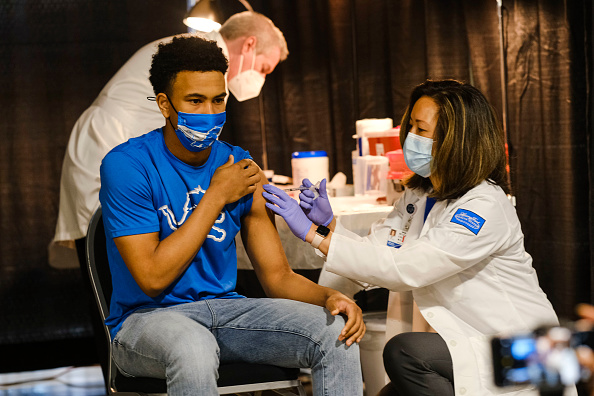Florida Surgeon General Joseph Ladapo called for a halt in the use of the Pfizer and Moderna COVID-19 mRNA shots on January 3, after the Food and Drug Administration and the Centers for Disease Control and Prevention did not respond to his questions on reports of DNA plasmid contaminants and oncogenic SV40 promoter genes, stated in a letter to the agencies.
DNA Contamination
A study that detected nanogram to microgram quantities of undisclosed dsDNA in the bivalent Moderna and Pfizer vaccines was conducted by Medical Genomics under the direction of CEO Kevin McKernan and made available on a preprint server on April 10. The findings of the study have been confirmed by numerous researchers, and the problem has been acknowledged by regulatory agencies.
At issue are two processes vaccine manufacturers use to create the spike protein mRNA from SARS-CoV2. While both processes use modified E.coli bacteria to produce spike protein mRNA, the polymerase chain reaction (PCR) method upon which emergency authorization approvals were granted is a “clean” process that is largely devoid of genetic contaminants.
However, the process used to mass produce vaccines for public consumption is “dirty,” utilizing fragments of oncogenic simian virus SV-40 to bind transcription factors that drag DNA into the cell, where they are then cut into smaller DNA strands by an enzyme. This second process can and does result in various DNA contaminants in the vaccines.
Due to the use of lipid nanoparticles to package vaccine components, contaminant double-stranded DNA (dsDNA) in the vaccines can be readily introduced into human cells, potentially triggering various health problems.
McKernan says the presence of dsDNA may contribute to blot clots; possible endotoxin contamination from E. coli, which can cause anaphylaxis; and an increased rate of mutagenesis caused by DNA contamination combined with disruption of the natural immune system and inhibition of tumor suppressor genes, which could explain the sharp increase in cancer rates since the vaccine rollout.
Altered DNA ‘Stick(s) Around’
Phillip Buckhaults, Ph.D., a professor at the University of South Carolina with expertise in cancer genomics, has suggested the risks of these foreign DNA inserting themselves into a person’s genome and becoming permanent are very real. Buckhaults has described himself as a “real fan” of mRNA technology but says DNA contamination is an issue that must be resolved.
Buckhaults recently testified on the subject before a South Carolina Senate Medical Affairs Ad-Hoc Committee, along with Sin Lee, M.D., Brigitte Konig, and David Speicher who were co-witnesses and contributed to the findings.
“I’m kind of alarmed about this DNA being in the vaccine,” Buckhaults told the legislators. “DNA is a long-lived information storage device. It’s what you were born with, you’re going to die with and pass on to your kids. So, alterations to the DNA…well, they stick around.”
Buckhaults says the contamination was exacerbated by the unreported shift from PCR to the more problematic plasmid method in the vaccines administered to the public, with manufacturers then apparently attempting to cover the use of plasmids by adding an enzyme (DNAase) to cut the plasmid into tiny fragments.
“[Pfizer] chopped them up to try to make them go away, but they actually increased the hazard of genome modification in the process,” said Buckhaults. “I don’t think there was anything nefarious here, I just think it was kind of a dumb oversight. They just didn’t think about the hazard of genome modification…it’s not all that expensive to add another process to get it out.”
Risks Downplayed?
Jane M. Orient, M.D., executive director of the Association of American Physicians and Surgeons, says contamination risks are being downplayed, but that exacerbating factors such as lipid nanoparticle encapsulation and other means of enhancing transfection, or insertion, of mRNA in vaccines necessarily increases the DNA contamination.
“Out of an abundance of caution, the level of such residual DNA is to be kept to a minimum through careful purification steps taken during the vaccine production, and every vaccine lot is to be carefully tested for the residual level,” said Orient.
“Regulators claim that vaccines with higher-than-accepted levels are not supposed to be released for public distribution. Meanwhile, as manufacturers and regulators assert that any leftovers of plasmid DNA are biologically inert, there are plausible mechanisms for unwanted effects when DNA fragments are transfected during the vaccination process.”
“Those adverse effects may occur mainly via DNA integration into and hence modification of the genomes of the transfected cells,” said Orient. “This possibility is enhanced when those DNA fragments are packaged in lipid nanoparticles, along with the mRNA particles, as has occurred in the mRNA vaccines. Compared with accidentally encountered free strings of DNA, those peculiar DNA contaminants may have enhanced persistence and increased transfection efficiency.”
Unanswered Questions
Lapado’s letter asked whether drug makers “evaluated the risk of human genome integration or mutagenesis of residual DNA contaminants from the mRNA COVID-19 vaccines alongside the additional risk of DNA integration from the lipid nanoparticle delivery system and SV40 promoter/enhancer,” and whether the FDA requested information from the drug makers to investigate such risk.
The letter also asks if current safety standards have considered the lipid nanoparticle delivery system used in the COVID-19 shots and given the “potentially wide biodistribution of mRNA COVID-19 vaccines and DNA contaminants beyond the local injection site,” whether the agencies evaluated the risk of DNA integration into reproductive cells.
Kevin Stone (kevin.s.stone@gmail.com) writes from Arlington, Texas.





















